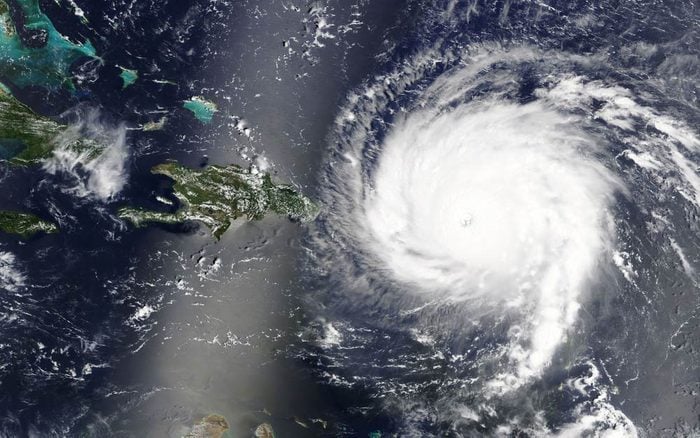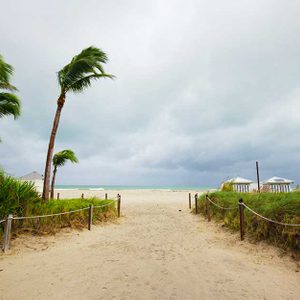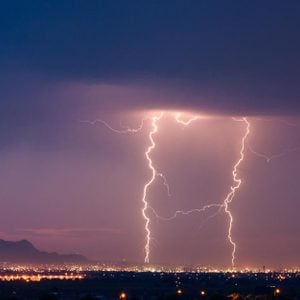How Exactly Are Hurricane Names Chosen?
Updated: Aug. 12, 2024

Nope, it's not random—hurricane names are decided years in advance. Learn how and who gets to name them.
Katrina. Harvey. Sandy. Just hearing these hurricane names brings back memories of fierce winds and torrential rains. In 2022, hurricanes like Danielle, Fiona and Ian made their presence known. Fast forward to 2023, and we met Harold, Idalia and Nigel. So far, 2024 hasn’t lagged behind either, with Hurricane Beryl and now Hurricane Debby making headlines—the former being the second named storm and the first hurricane of the year. But ever wondered how these hurricanes get their names? And who’s the mastermind behind this naming process?
If you live in a hurricane-prone area, this might not be your burning question. After all, knowing how to prepare for a hurricane and a tornado is crucial to keep your family safe from any disaster. But once you’re all set on the preparedness front, why not dive into the intriguing world of hurricane naming?
Keep reading to uncover the fascinating process behind hurricane names.
Get Reader’s Digest’s Read Up newsletter for more fun facts, humor, cleaning, travel and tech all week long.
How are hurricanes named?
Originally, hurricanes were named after the saint’s day when the storm hit. For instance, there have been two Hurricane San Felipes in Puerto Rico—one on Sept. 13, 1876, and another on that same date in 1928.
But by the 1900s, an Australian meteorologist started a new system. Instead of creating hurricane names based on saints, he used women’s names. The United States followed suit in 1953. And by 1979, men’s hurricane names were added to the mix.
Who names hurricanes?
Unsurprisingly, meteorologists name hurricanes. The World Meteorological Organization has six different lists—each with 21 names, one for every letter of the alphabet except Q, U, X, Y and Z—that they cycle through for hurricanes in the Atlantic. Hurricane names for storms on the West Coast come from another set of six lists—which include every letter except Q and U. Once six years go by, the naming starts again with the first list, save for any hurricane names that have been retired (more on that, below).
But how are hurricanes named if there are more than 21 storms (or 24 in the Pacific)? If this happens, then the rest of the names will come from the Greek alphabet, starting with Alpha and ending with Omega.
What are the hurricane names for 2024?
The 2024 names below are assigned to hurricanes, tropical storms and other systems formed in the Atlantic Ocean. Since there are six sets of names, rotated every six years, the hurricane names selected for 2024 will be reused in 2030.
- Alberto
- Beryl
- Chris
- Debby
- Ernesto
- Francine
- Gordon
- Helene
- Isaac
- Joyce
- Kirk
- Leslie
- Milton
- Nadine
- Oscar
- Patty
- Rafael
- Sara
- Tara
- Valerie
- William
What were the hurricane names for 2023?
According to the National Oceanic and Atmospheric Administration, the 2023 Atlantic hurricane season featured 19 named storms—which we share below.
- Hurricane Don
- Hurricane Franklin
- Hurricane Idalia
- Hurricane Lee
- Hurricane Margot
- Hurricane Nigel
- Hurricane Tammy
- Tropical Storm Arlene
- Tropical Storm Bret
- Tropical Storm Cindy
- Tropical Storm Gert
- Tropical Storm Emily
- Tropical Storm Harold
- Tropical Storm Jose
- Tropical Storm Katia
- Tropical Storm Ophelia
- Tropical Storm Philippe
- Tropical Storm Rina
- Tropical Storm Sean
What are the retired hurricane names?
Hurricane names are retired by the Hurricane Committee of the World Meteorological Organization during their annual meetings. According to the NOAA, this is done “if a storm is so deadly or costly that the future use of its name on a different storm would be inappropriate for obvious reasons of sensitivity.” Retiring a hurricane name also prevents confusion in future seasons. As of 2024, 96 names have been retired, some we share below.
- Katrina, retired after devastating New Orleans in 2005
- Irene, retired after devastating the Caribbean and East Coast in 2011
- Sandy, the largest Atlantic hurricane by diameter, retired after devastating the Eastern seaboard in 2012
- Harvey, retired after devastating Texas and Louisiana in 2017
- Irma, retired after devastating Florida in 2017
- Maria, retired after devastating Puerto Rico in 2017
- Ida, the second-most damaging and intense hurricane to hit the U.S., retired after devastating Louisiana in 2021
- Fiona, retired after devastating the Caribbean and eastern Canada in 2022
It’s worth mentioning that when a hurricane name is retired, a replacement name starting with the same letter will be given. For example, Hurricane Fiona will be replaced by Hurricane Farrah in 2028.
Additional reporting by Marissa Laliberte.
Sources:
- National Oceanic and Atmosphere Administration: “NOAA predicts above-normal 2024 Atlantic hurricane season”
- National Hurricane Center and Central Pacific Hurricane Center: “Tropical Cyclone Naming History and Retired Names“
- National Hurricane Center and Central Pacific Hurricane Center: “Tropical Cyclone Names“
Why trust us
At Reader’s Digest, we’re committed to producing high-quality content by writers with expertise and experience in their field in consultation with relevant, qualified experts. We rely on reputable primary sources, including government and professional organizations and academic institutions as well as our writers’ personal experience where appropriate. We verify all facts and data, back them with credible sourcing and revisit them over time to ensure they remain accurate and up to date. Read more about our team, our contributors and our editorial policies.






















